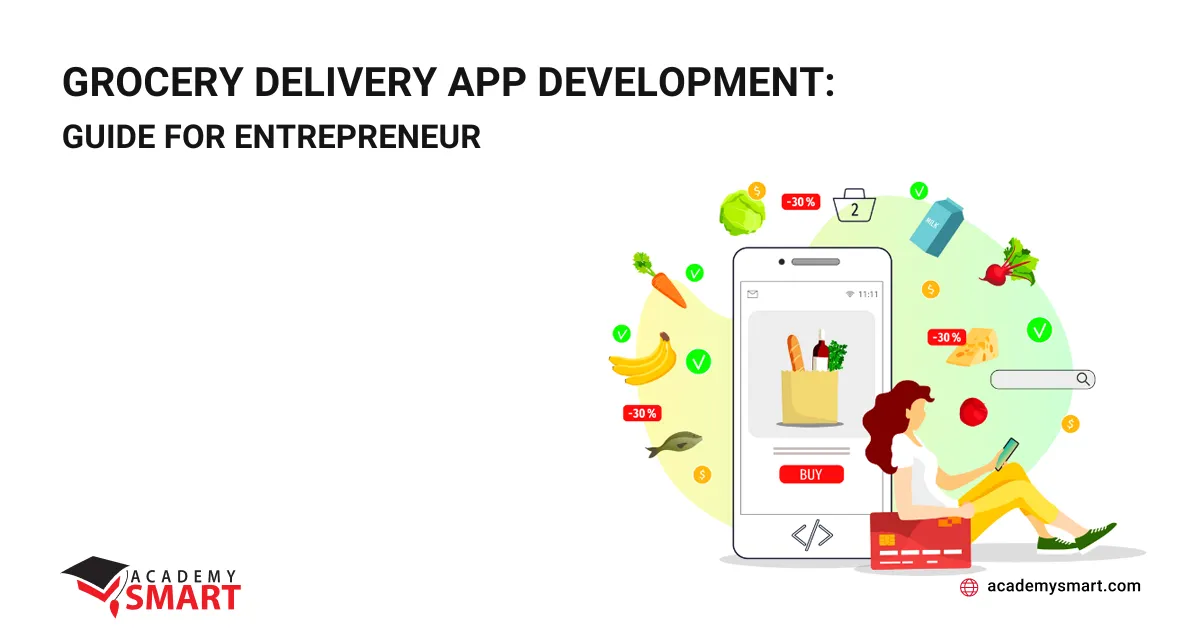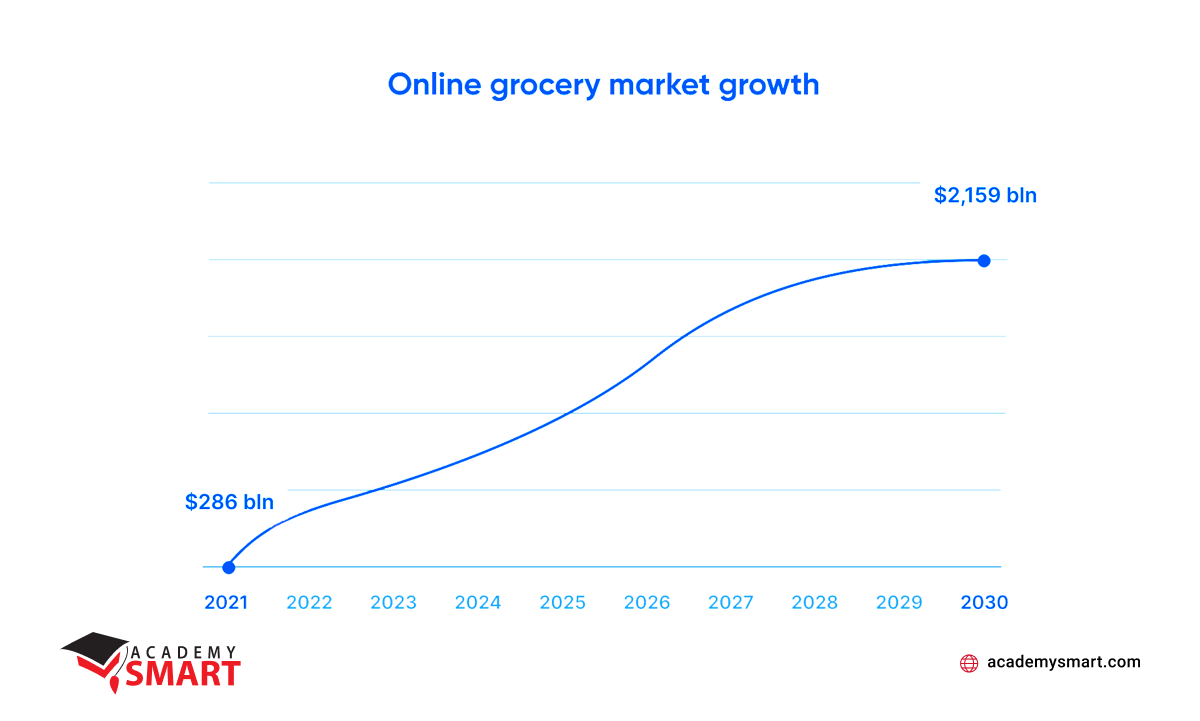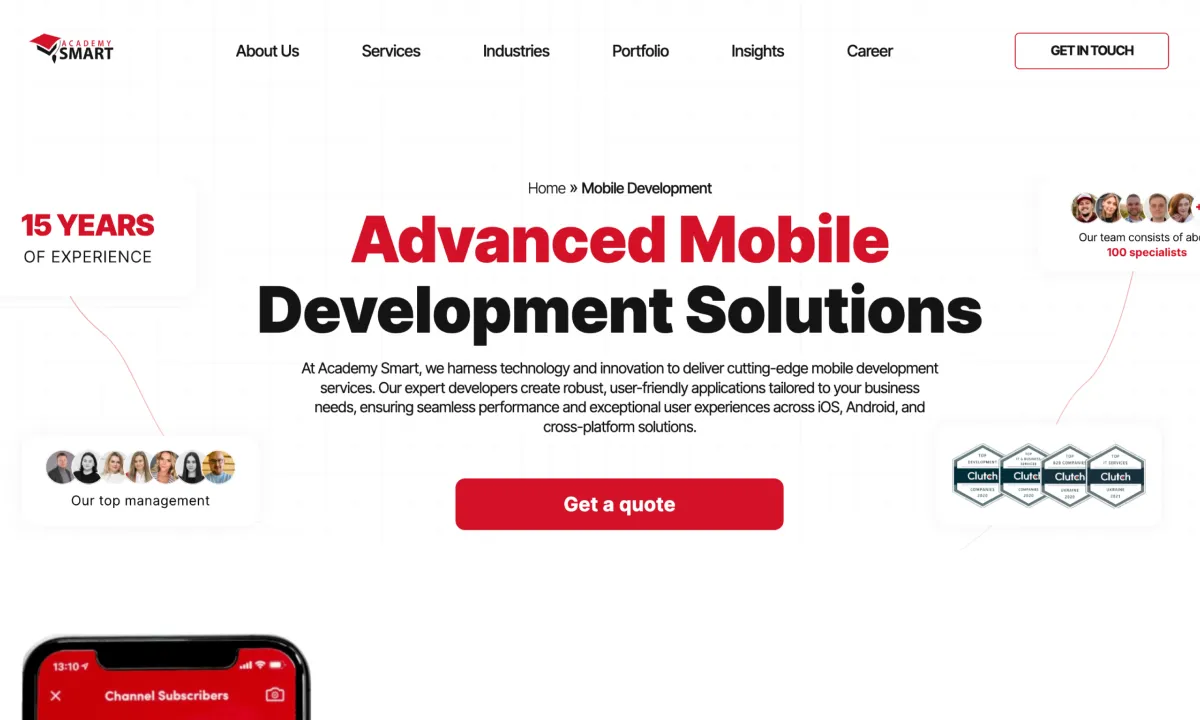
Grocery Delivery App Development: Guide for Entrepreneur
Contents
As owners of grocery stores, every day, you spend a lot of time and effort on attracting new customers and retaining their loyalty. However, it’s no secret that competition in this niche is becoming increasingly intense since this business is actively moving online. Let’s face reality: many entrepreneurs have already invested in their grocery ordering app development, especially during the COVID-19 pandemic, gaining significant customer acquisition and business process optimization advantages now. This guide aims to help you create a grocery delivery app to maintain your business positions and get a new source of profit.
What is GDA and How It Works
A grocery delivery app is an online software application for daily usage designed to manage ordering, paying for, and receiving food goods.
Typically, such an application consists of several software subsystems for customers, couriers, and owner-administrators, with specific features for each role. The web-hosted app usually exploits cloud computing services for data storing and processing scaling.
In practice, users download the mobile or web grocery delivery software and register, then browse through a virtual catalog of products categorized by type. They select desired items, add them to a virtual shopping cart, and proceed to checkout, reviewing their order and choosing a delivery time slot.
Usually, the app provides several payment options like credit/debit cards or mobile wallets. Once confirmed, the order is forwarded to a nearby grocery store or warehouse where staff prepare it for delivery.
A delivery person is assigned to pick up and deliver the order to the customer’s address. Users can track their order status in real time, rate the experience, and provide feedback within the app.
The grocery delivery application is a convenient and modern tool that expands the range of home delivery business services. Today, the market offers template-based solutions out-of-the-box or the creation of customized grocery delivery apps as a particular service of software development companies like Academy Smart.

How grocery delivery application works
Grocery delivery app types and business models
Grocery delivery apps employ two primary business models to satisfy diverse customer needs and receive income.
The subscription-based model requires users to pay recurring fees, either monthly or annually, granting access to the delivery service. This model offers benefits like discounted delivery fees, priority slots, and exclusive deals, attracting frequent shoppers seeking convenience. For instance, Kroger’s Delivery Savings Pass and Walmart’s Walmart+ offer subscribers free or discounted deliveries as part of their membership programs.
On the other hand, the on-demand model allows users to pay per order without subscription commitments. This flexibility appeals to a broader audience, including occasional shoppers who value convenience but don’t require regular deliveries. Revenue is generated through delivery fees and potential partnerships with grocery stores or brands for product placement or advertising within the app.
Depending on the business goals, there are two main online grocery delivery software types: single-store and aggregator applications.
Individual grocery stores develop single-store apps to digitize the delivery of their products. Whether it’s a small local store or a nationwide chain, these apps operate only for the specific store associated with them. A prime example is Walmart, whose app allows customers to order groceries from branded supermarkets across the United States.
On the other hand, aggregator apps act as intermediaries connecting multiple grocery stores with customers. They provide users with a list of nearby stores where they can shop. Customers place orders through the app, and the responsibility for order fulfillment lies with the respective store or a designated delivery team. Companies like DoorDash or Instacart follow this model, offering a wide range of products from various third-party suppliers while managing promotion and delivery themselves.
Each model serves different purposes: single-store apps are ideal for brands looking to expand online. In contrast, aggregator apps provide access to multiple stores through a single platform, like a marketplace. Accordingly, the methods of monetizing these app types also differ.
GDA benefits for owners and customers
Online grocery ordering software is applicable for simple users and has excellent potential for raising profits for its owner.
Users of your white-label grocery delivery app will appreciate the convenience and safety of online ordering, the speed of delivery, and the opportunity to save money on special offers, discounts, and promotional coupons. You may advance customer engagement and loyalty if you implement well-thought-out service personalization options.
Grocery delivery apps typically provide couriers with a user-friendly interface for accepting orders, tracking delivery routes, and interacting with customers. Couriers can also choose working hours that suit them and accept orders according to their schedule, making their work more organized and efficient.
On-demand grocery apps allow store owners to reach new clients who prefer to buy products online. Such a service attracts customers who might otherwise avoid going to the store due to work or other circumstances, raising sales and revenue. At the same time, you do not need to periodically spend money on printing and distributing promotional materials such as leaflets, which saves you money. Finally, a good grocery delivery service boosts relations with actual buyers and brings new ones. Satisfied customers return and recommend the store to their friends and families.
Grocery delivery apps often have order management, inventory, and shipment tracking tools, aiding owners in administering their enterprises. Grocery store navigation apps also provide precise customer behavior analytics. It lets store managers make informed decisions and enhance their marketing and sales strategies.
Why build GDA
The online grocery market is experiencing exponential expansion globally. Factors contributing to this growth include:
- the convenience of online shopping;
- the desire to save time;
- the high availability of mobile devices.
The global online grocery market, grossing $286 billion in 2021, is expected to reach a staggering $2,159 billion by 2030.
Trends display that a significant portion of customers prioritize convenience above all else, making it essential for businesses to offer easy-to-use applications that suit this preference. In the U.S. alone, online grocery is expected to swell to 21.5% of total grocery sales by 2025, doubling its share since 2021.
The COVID-19 pandemic has led to a surge in the usage of grocery delivery apps as consumers seek safe shopping options while adhering to social distancing guidelines. Research indicates that online grocery delivery apps generated $339,257 million in 2022, with projections indicating a growth rate of 9.6% to reach $447,496 million by 2025. Furthermore, heavy competition in the market underscores the attractiveness of the grocery delivery sector.
Lastly, focusing on instant delivery reshapes the grocery delivery practice, as companies prioritize same-day or instant delivery options. This trend, coupled with the introduction of subscription-based models offering free delivery, further enhances the appeal of grocery delivery apps to consumers. Today, major players worldwide boast rapidly diminishing delivery times, with the average order clocking at an hour or less.

Online grocery delivery market growth trend
GDA examples
Let’s look at famous grocery ordering software that became examples of successful grocery delivery application development.
Amazon Fresh provides grocery delivery from local and national grocery chains, including Whole Foods Market, which Amazon bought in 2017. Customers can enjoy the convenience of ordering groceries online and having them delivered to their doorstep, with the option to shop in-store if preferred. While Amazon Fresh typically requires a Prime membership, SNAP EBT users can access the service without a subscription, expanding its accessibility.
Instacart operates as an aggregator-type app, partnering with over 40,000 stores across the United States. Customers can browse a vast catalog of products and select items for same-day delivery. The advanced filtering system and real-time order tracking of the application fulfill the preferences of convenience-oriented consumers.
A retail giant, Walmart offers a comprehensive grocery delivery service through its app. Customers can purchase groceries and household items from a diverse catalog, with the option for quick delivery within hours. Innovative InHome delivery service that goes directly to the house for a monthly subscription fee is notable for convenience and security.
Shipt follows an aggregator model, connecting customers with personal shoppers from a nationwide fleet of independent contractors. Shipt offers customization options like setting dietary preferences and selecting favorite shoppers. The app covers more than 5,000 cities in the U.S. and provides same-day delivery service to a wide range of consumers.
Uber Eats, initially known for restaurant meal delivery, has expanded its services to include grocery delivery. Suggesting delivery from local retailers and restaurants, Uber Eats ensures flexibility and convenience to customers seeking various goods. With options for contactless delivery and subscription-based benefits such as waived delivery fees, Uber Eats aims to meet the evolving consumers’ needs.

Robotic fulfillment solution for warehouses we developed
Grocery Delivery Application Development Guide
On-demand grocery delivery app development requires a clear vision of the project’s goals, selecting an appropriate feature set, and the right technology stack. Even though creating such a software product is trivial for experienced web application developers, paying attention to their counter offers and technical advice is wise. That can reduce development cycle times and the financial resources required. Use the advice in the article “How to Hire Software Developers for a Startup: 7 Essential Tips” when choosing the right team of programmers.
How much does it cost to develop GDA
The grocery app development cost can vary significantly depending on various factors, such as the type of team hired, the team’s location, the app’s complexity, and the features required.
For instance, the price for an on-demand grocery app development typically ranges from $45,000 to $150,000. Hiring an in-house team might cost around $100,000 with an hourly rate of $80 for an MVP while working with a local agency could increase the cost to approximately $225,000 with a payment of $175 hourly. On the other hand, opting for freelancers might lower the price to around $25,500 for an MVP with hourly rates in the range of $20-40. Generally, middle offshore IT companies like Academy Smart charge $30 to $75 per hour, and larger or nearshore firms charge $75 to $200 per hour.
The cost of developing apps similar to Walmart Grocery, Shipt, Uber Eats, or Instacart could also vary. Walmart Grocery may cost around $75,000 to create, while apps like Shipt cost approximately $70,000. Uber Eats and Instacart require budgets of around $90,000 and $85,000, respectively. In any case, each project is calculated individually based on the specification and composition of the web development experts involved.
How much time does it take to develop GDA
The time required for grocery app development can vary depending on the approach and the project’s sophistication. Typically, we may divide the process into two main stages: discovery and development.
During the discovery stage, which typically lasts 1-2 weeks, the focus is on finalizing the app idea, preparing functional specifications, and creating UX/UI designs. You have to get the user-friendliness and visual appeal of the application’s interface across different devices and operating systems before starting the back-end programming.
Following this, the development phase begins. This phase implies building either a Minimum Viable Product (MVP) or a full-fledged project. MVP creation is a generally accepted practice for testing and verifying the app idea without incurring unnecessary financial risks. The development timeline for an MVP can range from 3 to 5 weeks, depending on factors such as the feature set and the size of the development team. Once the app is developed, it should be launched and promoted to attract users.
Overall, the entire process of grocery ordering app development can take approximately 2 to 4 months, depending on various factors and the project’s specific requirements.
GDA development: choosing the stack
Let’s look at what components are common in grocery delivery app development and why.
As the grocery delivery app is a web-hosted solution, the technology stack based on JavaScript is a good choice. JavaScript is a universal coding language for both front- and back-end. TypeScript option improves code quality and maintainability. You may use the Python and Java programming languages and their frameworks for specific back-end tasks.
JS-framework React.js exploits a component-based approach to building user interfaces, making it highly efficient for creating interactive and dynamic web applications. Node.js, with its asynchronous and event-driven architecture, is ideal for operating server-side logic and API integrations.
Using React Native, developers create cross-platform mobile applications. It quickly renders native UI components with a smooth user experience on various devices. Another universal solution for mobile development might be Flutter. Kotlin and Swift are good for building native mobile apps for GDAs.
PostgreSQL is a database management system with high integrity and performance in data processing. JSONB data type and full-text search support can also be helpful in grocery store app development.
GraphQL is a flexible way to query and manipulate data, allowing clients to request only the needed data. Its clear syntax and strong typing system make it well-suited for developing APIs to interconnect web applications.
Google Maps API provides exact and reliable geolocation services like maps, finding addresses, and getting directions. It’s well-documented and easy for developers to use, making it perfect for adding location features to GDAs.
PayPal and Stripe are popular payment gateways because they’re easy to set up and secure. They support many payment methods and currencies. They are excellent choices for driving payments in grocery delivery apps.
Amazon AWS delivers the whole toolset for cloud computing like storage, scaled instances, or AI processing. Tools like Prometheus and Grafana help devs monitor application performance in real time.

Technology stack for grocery app development
GDA key features for customers
When building a grocery delivery app, your development team should implement several must-have features for customers to enable a smooth and engaged user experience.
Firstly, a simple registration process is crucial, allowing users to sign up quickly via social media accounts or email, confirming easy access to the platform. Once registered, users should have access to profile management features, enabling them to update their personal information and preferences as needed.
The catalog is an app’s core, where users can browse various product categories with precise representations of items. A robust search function with multiple filters and voice search capability enhances user experience.
Order placement has to include a straightforward checkout process synced with user profiles and multiple payment options for convenience. Delivery scheduling options provide flexibility, while order status tracking informs users about purchases. After completing an order, users should receive receipts for their purchases and the ability to rate and review products and services. Push notifications further engage users by updating order statuses and special deals.
Advanced features like bookmarks for saving favorite items, order history for easy reordering, and loyalty programs for customer retention can elevate the app’s functionality. Integration with social networks is needed for quick sharing of products and experiences on the Web.
Finally, features of delivery time estimation, multilingual interface, personal suggestions, and real-time order tracking sweeten user satisfaction.
GDA key features for owners
In developing a grocery delivery app, owners require features in the admin panel to manage operations and ensure a seamless user experience efficiently.
Firstly, your GDA needs customer data management to coordinate deliveries and implement targeted marketing strategies. Your app should efficiently gather customer-related details such as names, addresses, and contact information. It is also important to provide a convenient system for alerting users through periodic mailings and push notifications.
A comprehensive list of stores is crucial for aggregator apps, providing users with options from different neighborhoods. Owners must ensure easy access to store information through manual integration or APIs.
Managing menus and items in stock is fundamental. This feature enables users to have access to up-to-date information on product availability.
Your platform needs tracking revenue tools to provide data for financial management and business strategy correction.
In addition to these core features, owners may require advanced GDA functionalities like order management, store management, product management, transaction history, content management, reports and analytics, and loyalty programs.
Build Your Grocery Delivery Software with Academy Smart’s Team
Academy Smart has created custom web and mobile enterprise applications for over 14 years. Our outstaffing IT agency invites you to hire specific IT experts to augment your in-house workforce. Our team comprises IT specialists with various practical experiences in building web-based, hybrid, or cloud-native business software.
With our help, you can implement any business model and working mechanics of the application, creating apps on demand similar to Shipt, Instacart, Hungryroot, etc. When you choose us as your grocery delivery app development company, you may get a user-friendly and cost-efficient software product turnkey to make you profit and satisfy your customers. Get in touch to share details of your grocery shopping app vision.
Frequently Asked Questions: Grocery Delivery App Development
How to start a personal grocery shopping business in 2024?
Conduct market research and write a business plan with services, pricing, and marketing strategy. Then, create a grocery delivery app and partner with local stores to establish logistics and get products.
How much does it cost to build a grocery store online?
Grocery app development costs vary significantly depending on platform complexity, features, design requirements, and development resources. At Academy Smart, you may hire a full-stack development team for $ 35-60 per work hour for IT specialists.
Book a free consultation

Reach out to start talking today!










